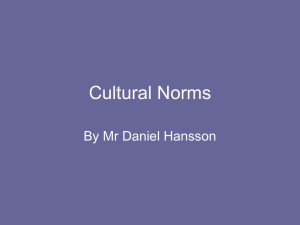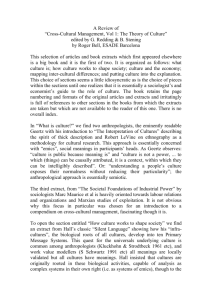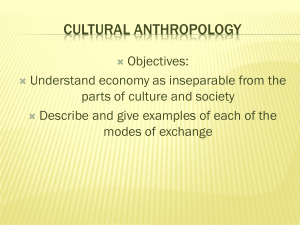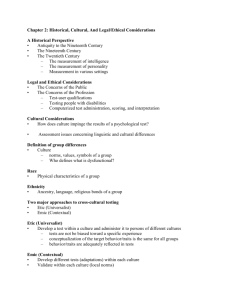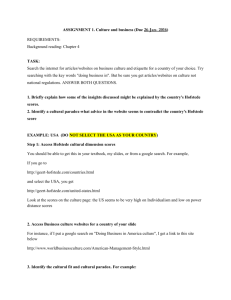Folie 1
advertisement
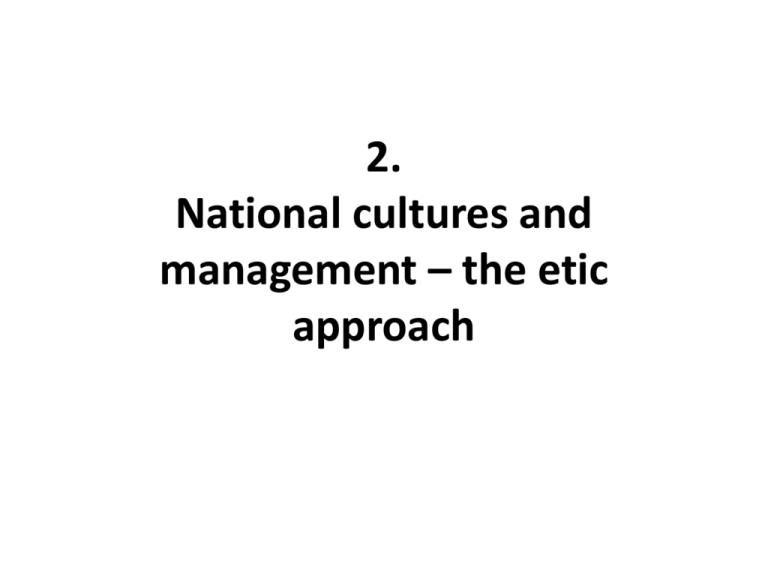
2. National cultures and management – the etic approach Learning objectives • • • • • • • • • • define the concept of culture distinguish between culture and stereotypes understand different views on the origins of national culture evaluate the usefulness of the emic and etic approaches to cultural analysis understand methodological difficulties in national culture research understand and appreciate the strengths and weaknesses of Hofstede’s work, Schwarz’s work, and the World Values Survey relate the three main etic studies of national culture to one another recognize the implications of the cultural differences identified by etic studies for management and organization understand the differences between culture at the national and at the organizational level recognize the implications of cultural differences at the national level for international negotiations. Chapter Outline (1) 2.1 Introduction 2.2 What culture is and is not Defining culture Culture and stereotypes Where does culture come from? 2.3 Methodological dilemmas Etic versus emic Research methods Boundaries of cultures Levels of analysis Dimensions and typologies Chapter Outline (2) 2.4 2.6 2.7 2.8 Examples of etic research Geert Hofstede: Five dimensions of work-related values Shalom Schwartz: Seven cultural orientations World Values Survey: national cultures over time Integration National culture and organizational culture Implications for management and organization National cultures and cross-cultural negotiations Study questions Further reading Case: Leading across cultures at Michelin Case: The Alcatel-Lucent merger Notes References Figure 2.1: Levels of culture Figure 2.2: Theoretical structure of Schwartz‘s cultural value orientations Figure 2.3: Culture clusters in the World Values Survey data (source: http://commons.wikimedia.org/wiki/User:Koyos, retrieved 28 March, 2014. Figure 2.4: Culture change in countries on two dimensions (Source: Inglehart and Baker, 2000: 40) Figure 2.5: Fourteen dimensions of national cultures (Sources: Hofstede [2001]; Schwartz [private correspondence]; World Values Survey website [http://www.worldvalues survey.org/wvs.jsp]) Figure 2.6: Hofstede‘s onion diagram (Source: Adapted from Hofstede, 1991) Figure 2.7: Influences of culture on negotiations (Source: adapted from Gelfand and Dyer, 2000) Study questions Explain the differences and similarities between the concepts of culture and stereotypes. 2 Discuss how culture may influence the chances of survival of groups of people in a particular natural environment. 3 Describe the differences between etic and emic culture research. 4 Give an account of possible issues of level of analysis in culture research. 5 Describe and critically discuss Hofstede’s model of culture dimensions. 6 Describe and critically discuss Schwartz’s model of culture orientations. 7 Describe and critically discuss the approach of Inglehart and the World Values Survey. 8 Discuss the relative strong and weak points of the work of Hofstede, Schwartz and Inglehart. 9 Compare the concepts of national culture and organizational culture, and explain the differences and similarities. 10 Give examples of how national culture may influence management and organization. 11 Explain how cultural differences may influence negotiation processes and outcomes. 1

